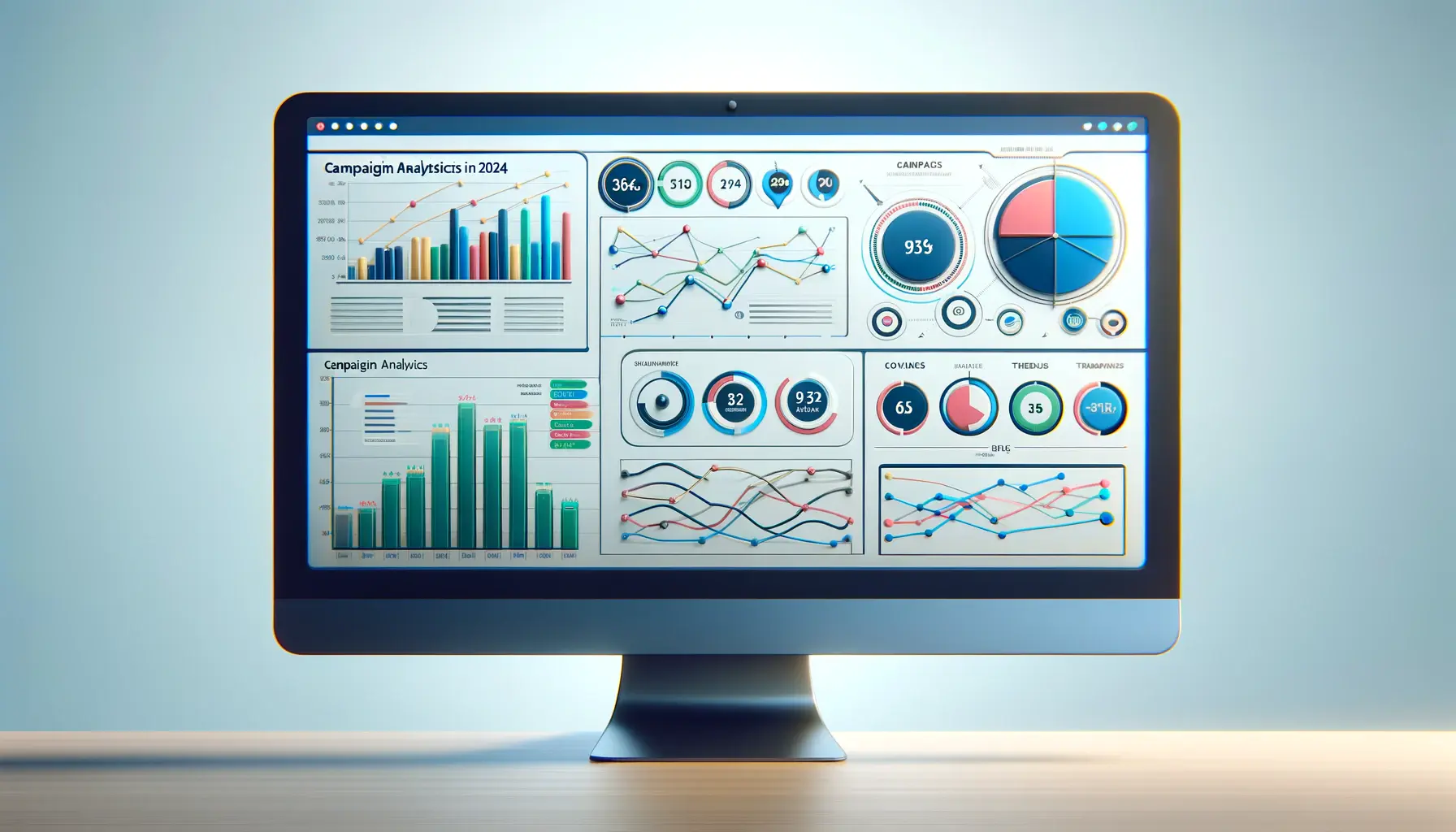The digital marketing landscape is evolving at an unprecedented pace, and as we step into 2024, the reliance on campaign analytics has become more crucial than ever.
In an era where data is king, understanding the intricacies of campaign analytics offers businesses a competitive edge, enabling them to optimize their marketing strategies effectively.
Campaign analytics, particularly within the realm of Apple Search Ads Measurement, has emerged as a pivotal tool for marketers aiming to navigate the complexities of digital advertising with precision and insight.
The significance of campaign analytics extends beyond mere data collection; it encompasses the analysis, interpretation, and application of data to drive strategic decisions.
As businesses vie for visibility in a saturated digital space, the ability to dissect and leverage campaign data can mean the difference between success and stagnation.
This article delves into the multifaceted role of campaign analytics in shaping the future of digital marketing, highlighting its impact on strategy formulation, performance optimization, and ROI enhancement.
- Understanding the Fundamentals of Campaign Analytics
- Strategies for Optimizing Campaign Performance
- Enhancing User Experience Through Data Insights
- Leveraging Competitive Intelligence
- Integrating Multichannel Strategies
- Adapting to Technological Advancements
- Measuring and Analyzing Campaign Success
- Conclusion: The Pivotal Role of Campaign Analytics in Shaping Digital Marketing Success
- Campaign Analytics in 2024: Frequently Asked Questions
Understanding the Fundamentals of Campaign Analytics
Campaign analytics serves as the backbone of effective digital marketing strategies.
At its core, it involves the systematic analysis of campaign data to uncover insights that inform decision-making processes.
This encompasses a broad spectrum of activities, from tracking user engagement and conversion rates to analyzing customer behavior and campaign effectiveness.
The primary objective is to identify patterns and trends that can guide the optimization of future campaigns.
In the context of Apple Search Ads Measurement, campaign analytics takes on added significance.
With Apple’s platform offering unique opportunities for targeting and reach, understanding the nuances of campaign performance becomes essential.
Marketers must navigate the platform’s specific metrics and data points, such as impression share, conversion rates, and cost per acquisition, to tailor their strategies for maximum impact.
This not only enhances the efficiency of ad spend but also ensures that campaigns resonate with the intended audience.
Key Metrics and Their Impact
The effectiveness of campaign analytics hinges on the careful monitoring of key performance indicators (KPIs).
Metrics such as click-through rate (CTR), conversion rate, and return on ad spend (ROAS) offer valuable insights into campaign performance.
By analyzing these metrics, marketers can gauge the effectiveness of their ads, identify areas for improvement, and adjust their strategies accordingly.
This data-driven approach enables the fine-tuning of campaigns to ensure they align with business objectives and market demands.
Moreover, in the realm of Apple Search Ads, additional metrics like app download rates and user engagement levels become critical.
These indicators provide a deeper understanding of how well campaigns are performing in driving tangible outcomes, such as app installations and active usage.
By focusing on these metrics, marketers can optimize their campaigns to not only attract users but also encourage meaningful engagement with their apps.
Understanding and leveraging the right metrics is crucial for optimizing campaign performance and achieving marketing objectives.
Strategies for Optimizing Campaign Performance
Optimizing campaign performance in the digital age requires a blend of creativity, analytics, and strategic planning.
As the digital landscape becomes increasingly competitive, marketers must employ a variety of tactics to ensure their campaigns stand out and deliver measurable results.
This section explores several key strategies that can enhance the effectiveness of your campaign analytics efforts, particularly within the framework of Apple Search Ads Measurement.
Segmentation and Targeting
One of the foundational steps in optimizing campaign performance is effective segmentation and targeting.
By dividing your audience into distinct groups based on demographics, interests, and behavior, you can tailor your campaigns to resonate with each segment.
This personalized approach not only improves engagement rates but also increases the likelihood of conversion.
- Demographic Segmentation: Tailor your ads based on age, gender, location, and other demographic factors to reach the most relevant audience.
- Behavioral Segmentation: Analyze user behavior to create targeted campaigns that cater to specific interests and purchasing habits.
- Interest-based Targeting: Utilize data on user interests to craft messages that speak directly to what your audience cares about.
Utilizing Advanced Analytics Tools
Advancements in analytics tools have revolutionized the way marketers approach campaign optimization.
Leveraging these tools can provide deeper insights into campaign performance, enabling more informed decision-making.
For Apple Search Ads, utilizing platform-specific tools and features can help fine-tune targeting, adjust bidding strategies, and improve overall campaign efficiency.
- Data Visualization: Employ tools that offer data visualization capabilities to better understand complex datasets and identify trends.
- Predictive Analytics: Use predictive models to forecast future trends based on historical data, helping to anticipate market changes and adjust strategies accordingly.
- A/B Testing: Implement A/B testing to compare different campaign elements, from ad copy to landing pages, and determine which variations perform best.
Incorporating a mix of segmentation, targeting, and advanced analytics tools is key to unlocking the full potential of your campaign analytics efforts.
Enhancing User Experience Through Data Insights
At the heart of successful digital marketing campaigns lies a superior user experience.
Leveraging data insights to enhance user interactions with your ads and platforms can significantly impact the effectiveness of your campaigns.
This approach not only fosters positive brand perception but also drives higher conversion rates.
In the context of Apple Search Ads and broader campaign analytics, understanding and improving user experience becomes a pivotal strategy.
Personalization and Relevance
Personalization is a critical component of enhancing user experience.
By utilizing campaign analytics to gather insights into user preferences and behaviors, marketers can create highly personalized ad experiences.
This level of customization ensures that ads are relevant to the audience, increasing engagement and the likelihood of conversion.
Personalization strategies can include tailored messaging, targeted offers, and content that resonates with the individual interests of the user.
- Customized Ad Copy: Craft ad copy that speaks directly to the user’s interests and needs, based on the data collected from their online behavior.
- Targeted Offers: Use analytics to identify opportunities for offering discounts or special promotions to segments of your audience that are more likely to convert.
- Dynamic Content: Implement dynamic content in your ads that changes based on user data to maintain relevance and capture attention.
Optimizing Landing Pages
The landing page experience is equally important in the user’s journey from ad click to conversion.
Utilizing insights from campaign analytics to optimize landing pages can significantly improve conversion rates.
This involves ensuring that the landing page is directly relevant to the ad content, loads quickly, and provides a seamless user experience on both desktop and mobile devices.
Additionally, incorporating elements such as clear call-to-action (CTA) buttons and simplified forms can enhance the effectiveness of your landing pages.
- Relevance: Ensure that the landing page content aligns with the ad’s message to meet user expectations and reduce bounce rates.
- Mobile Optimization: With a significant portion of web traffic coming from mobile devices, optimizing landing pages for mobile is crucial for maintaining user engagement.
- CTA Placement: Strategically place CTA buttons to guide users towards taking the desired action, whether it’s making a purchase, signing up for a newsletter, or downloading an app.
Enhancing user experience through personalized ads and optimized landing pages is essential for maximizing the impact of your campaign analytics efforts.
Leveraging Competitive Intelligence
In the dynamic realm of digital marketing, understanding your competition is as crucial as understanding your audience.
Leveraging competitive intelligence through campaign analytics provides insights into the strategies employed by your competitors, enabling you to identify opportunities for differentiation and innovation.
This strategic approach not only helps in refining your marketing efforts but also in positioning your brand effectively in the market.
Identifying Market Trends
Keeping abreast of market trends is essential for staying competitive.
By analyzing the broader trends within your industry, including the types of campaigns your competitors are running, their targeted keywords, and their ad spend, you can gain valuable insights into the market dynamics.
This knowledge allows you to adapt your strategies to meet market demands and capitalize on emerging opportunities.
- Market Analysis: Conduct thorough market analysis to understand the competitive landscape and identify key trends that are shaping the industry.
- Keyword Research: Use keyword research tools to discover which keywords your competitors are targeting and how you can differentiate your keyword strategy to capture untapped market segments.
- Ad Content Analysis: Review your competitors’ ad content to identify what resonates with the audience and how you can create more compelling and unique ad messages.
Benchmarking Performance
Benchmarking your performance against your competitors is another critical aspect of leveraging competitive intelligence.
By comparing your campaign metrics such as CTR, conversion rates, and ROAS with those of your competitors, you can gauge your relative performance and identify areas for improvement.
This comparative analysis helps in setting realistic performance goals and strategies for achieving them.
- Performance Metrics Comparison: Regularly compare your campaign performance metrics with industry averages and top performers to understand where you stand.
- Strategic Adjustments: Based on the benchmarking insights, make strategic adjustments to your campaigns to improve performance and competitiveness.
- Innovation and Differentiation: Identify gaps in your competitors’ strategies that you can exploit to differentiate your brand and offer unique value to your audience.
Utilizing competitive intelligence effectively allows for strategic positioning and innovative campaign strategies that can set your brand apart in a crowded marketplace.
Integrating Multichannel Strategies
In today’s fragmented digital landscape, integrating multichannel strategies into your campaign analytics approach is essential for reaching your audience across different touchpoints.
A multichannel strategy involves using a combination of channels—such as social media, email, search engines, and mobile apps—to engage with your audience.
This approach not only expands your reach but also enhances the effectiveness of your campaigns by providing multiple pathways for engagement and conversion.
Creating a Cohesive Brand Experience
Ensuring a cohesive brand experience across all channels is fundamental to the success of a multichannel strategy.
Consistency in messaging, visuals, and user experience helps in building brand recognition and trust.
Utilizing campaign analytics to track and measure the performance of each channel allows marketers to identify which channels are most effective for their audience and adjust their strategies accordingly.
- Brand Consistency: Maintain a consistent brand voice and visual identity across all channels to reinforce brand recognition.
- Performance Tracking: Use analytics tools to monitor the performance of each channel, enabling data-driven decisions on where to allocate resources.
- Channel Optimization: Continuously optimize each channel based on performance data to improve overall campaign effectiveness.
Leveraging Cross-Channel Data
One of the advantages of a multichannel strategy is the ability to leverage cross-channel data for a more comprehensive understanding of your audience.
By analyzing data from various channels, you can gain insights into customer behavior, preferences, and the customer journey.
This holistic view enables the creation of more targeted and personalized campaigns that resonate with your audience across different platforms.
- Data Integration: Integrate data from various channels to create a unified view of your audience and their interactions with your brand.
- Customer Journey Mapping: Use cross-channel data to map out the customer journey, identifying key touchpoints and opportunities for engagement.
- Personalized Campaigns: Develop personalized campaigns based on insights from cross-channel data to enhance relevance and engagement.
A successful multichannel strategy relies on the integration of consistent branding and the strategic use of cross-channel data to engage and convert your audience effectively.
Adapting to Technological Advancements
The digital marketing world is continuously shaped by technological advancements, making it imperative for marketers to stay abreast of new tools, platforms, and methodologies.
Adapting to these changes can significantly enhance the effectiveness of campaign analytics, providing more accurate insights and enabling more sophisticated targeting and personalization strategies.
This adaptability is particularly crucial in the context of Apple Search Ads and other platform-specific advertising solutions.
Embracing Artificial Intelligence and Machine Learning
Artificial Intelligence (AI) and Machine Learning (ML) are at the forefront of transforming campaign analytics.
These technologies offer the ability to process and analyze vast amounts of data at unprecedented speeds, uncovering insights that would be impossible for humans to detect manually.
By embracing AI and ML, marketers can automate complex analytical processes, predict consumer behavior, and optimize campaigns in real-time.
- Predictive Analytics: Utilize AI to forecast future consumer behaviors based on historical data, allowing for more targeted campaign strategies.
- Automated Optimization: Implement ML algorithms to automatically adjust campaign parameters for optimal performance based on real-time data.
- Personalization at Scale: Leverage AI to deliver personalized ad experiences to large audiences, enhancing engagement and conversion rates.
Exploring Emerging Platforms and Channels
As new platforms and channels emerge, they open up fresh avenues for reaching and engaging with audiences.
Staying ahead of the curve by exploring and integrating these new channels into your campaign strategy can provide a competitive edge.
Whether it’s the latest social media platform, a new advertising network, or an innovative content format, each offers unique opportunities for creative campaign execution.
- Channel Diversification: Continuously explore new channels and platforms to diversify your campaign strategy and reach broader audiences.
- Innovative Content Formats: Experiment with new content formats such as augmented reality (AR), virtual reality (VR), or interactive ads to engage users in novel ways.
- Early Adoption Benefits: Being an early adopter of emerging platforms can offer first-mover advantages, such as lower competition and higher engagement rates.
Adapting to technological advancements and exploring new platforms are key strategies for staying competitive and maximizing the impact of your campaign analytics efforts.
Measuring and Analyzing Campaign Success
At the culmination of deploying various strategies and integrating new technologies lies the critical phase of measuring and analyzing campaign success.
This process is vital for understanding the effectiveness of your marketing efforts and for informing future strategies.
In the realm of campaign analytics, especially within the context of Apple Search Ads Measurement, establishing clear metrics for success and continuously monitoring performance are essential steps toward achieving and exceeding marketing objectives.
Setting Clear Objectives and KPIs
Success in digital marketing begins with setting clear, measurable objectives and key performance indicators (KPIs).
These benchmarks serve as a guide for evaluating campaign performance and determining the return on investment (ROI).
Whether the goal is to increase brand awareness, drive sales, or enhance user engagement, defining specific KPIs such as conversion rates, click-through rates (CTR), and cost per acquisition (CPA) is crucial.
- Objective Alignment: Ensure that your campaign objectives align with your overall business goals to drive meaningful outcomes.
- KPI Selection: Choose KPIs that accurately reflect the success of your campaigns in relation to your objectives.
- Continuous Monitoring: Regularly monitor these KPIs to track campaign performance and make data-driven adjustments as needed.
Utilizing Analytics for Continuous Improvement
The power of campaign analytics lies not just in measuring success, but in leveraging data for continuous improvement.
By analyzing campaign data, marketers can identify what works, what doesn’t, and why.
This iterative process involves refining targeting strategies, optimizing ad creatives, and adjusting budget allocations to enhance campaign performance over time.
Utilizing advanced analytics tools and techniques can uncover deeper insights, enabling more strategic decision-making and innovative campaign approaches.
- Data-Driven Insights: Dive deep into campaign data to extract actionable insights that can inform strategic adjustments and optimizations.
- Iterative Optimization: Adopt an iterative approach to campaign management, continuously testing, learning, and refining based on performance data.
- Strategic Decision-Making: Use analytics to guide strategic decisions, from targeting and messaging to budgeting and channel selection.
Effective measurement and analysis are the cornerstones of successful campaign analytics, enabling marketers to achieve and surpass their marketing objectives through informed, data-driven strategies.
Conclusion: The Pivotal Role of Campaign Analytics in Shaping Digital Marketing Success
As we navigate through the complexities of the digital marketing landscape in 2024, the importance of campaign analytics cannot be overstated.
The insights derived from analyzing campaign data play a crucial role in informing strategic decisions, optimizing campaign performance, and ultimately achieving marketing objectives.
In an era where data-driven decision-making is paramount, the ability to harness the power of campaign analytics offers businesses a significant competitive advantage.
Driving Strategic Decisions with Data
The strategic application of campaign analytics enables marketers to make informed decisions that drive campaign success.
From setting clear objectives and KPIs to leveraging competitive intelligence and adapting to technological advancements, campaign analytics provides the foundation for a robust digital marketing strategy.
The insights gained from campaign data not only inform immediate campaign adjustments but also guide long-term marketing strategies.
Optimizing for Performance and Engagement
At the core of campaign analytics is the goal of optimizing campaign performance and enhancing user engagement.
Through detailed analysis of key metrics, segmentation and targeting, and the integration of multichannel strategies, marketers can fine-tune their campaigns for maximum impact.
Personalization and relevance, powered by advanced analytics tools, further ensure that campaigns resonate with the intended audience, driving higher conversion rates and fostering brand loyalty.
Embracing Innovation for Future Success
The landscape of digital marketing is ever-evolving, and the successful integration of campaign analytics requires an ongoing commitment to innovation and learning.
By staying ahead of emerging trends, exploring new platforms and channels, and continuously refining strategies based on data insights, marketers can ensure their campaigns remain effective and relevant.
The future of digital marketing lies in the ability to adapt, innovate, and leverage the rich insights provided by campaign analytics.
- The strategic use of campaign analytics is essential for making informed marketing decisions.
- Optimizing campaign performance and user engagement is key to maximizing ROI.
- Continuous innovation and adaptation to new technologies and platforms are crucial for staying competitive.
In conclusion, the role of campaign analytics in digital marketing is more critical than ever in 2024.
By effectively analyzing and applying campaign data, marketers can navigate the complexities of the digital landscape, achieve their marketing objectives, and drive business growth.
The insights gained from campaign analytics not only illuminate the path to success but also empower marketers to shape the future of digital advertising in innovative and impactful ways.
If you're seeking expertise in Apple Search Ads campaigns, visit our service page for professional management!
Campaign Analytics in 2024: Frequently Asked Questions
Explore common queries related to the pivotal role of campaign analytics in shaping digital marketing strategies in 2024.
Campaign analytics involves analyzing data from marketing campaigns to improve decision-making, optimize strategies, and enhance overall campaign performance.
As digital marketing evolves, campaign analytics provides the insights needed to navigate complex landscapes, ensuring strategies are data-driven and outcomes are optimized.
By analyzing campaign performance data, marketers can identify and invest in the most effective strategies, enhancing efficiency and maximizing return on investment.
Key metrics include click-through rates, conversion rates, engagement levels, and return on ad spend, offering insights into campaign effectiveness.
Apple Search Ads Measurement provides specific metrics for app campaigns, helping marketers optimize for visibility and conversion within the App Store.
Yes, through predictive analytics and machine learning, campaign analytics can forecast trends, enabling proactive strategy adjustments.
Segmentation and targeting are refined through analytics, allowing marketers to tailor campaigns more effectively to different audience segments.
Advancements in technology, like AI and ML, enhance the precision and efficiency of campaign analytics, enabling more sophisticated marketing strategies.















